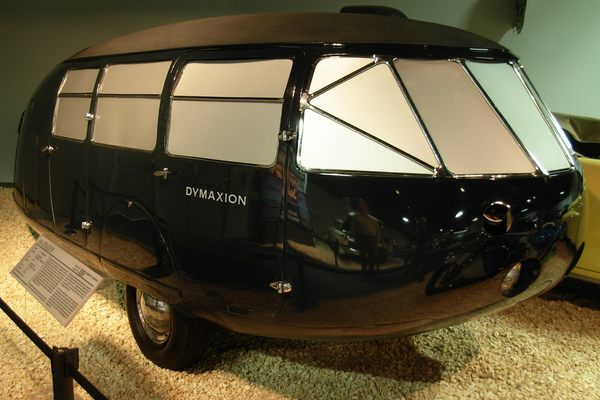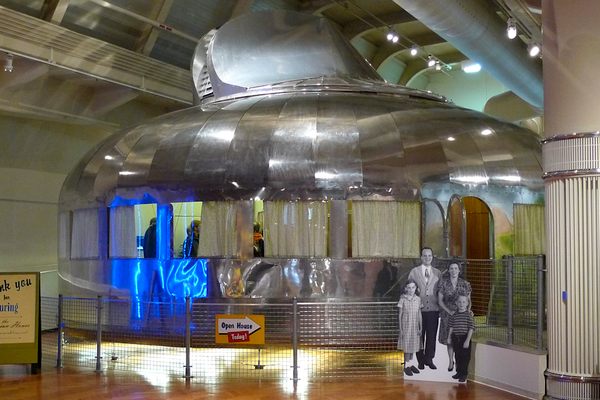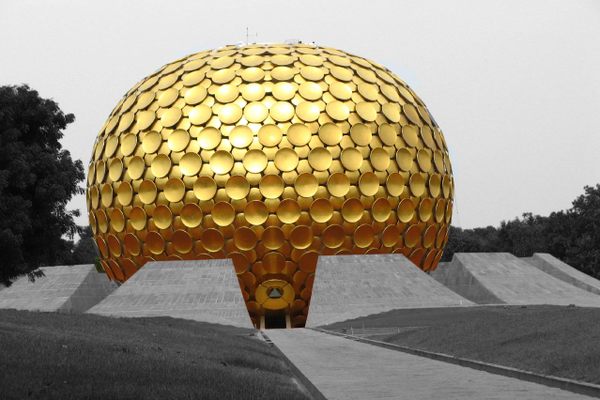Bucky’s World: Explore a Better Designed Future with Buckminster Fuller
Today we celebrate Buckminster Fuller, who was born July 12, 1895 in Massachusetts. The world isn’t quite like the prolific architect, designer, mathematician, public speaker, artist, futurist, and author dreamed it would be. Sure, we may have geodesic robots stalking around, but we’re a long way from working in geodesic domes, driving in 11-person three-wheeled cars, or living in metal houses that independently sustain themselves.
However, Fuller’s vision for a better designed world, where we could do more with less, is still out there for us to see, and maybe through revisiting these stray prototypes, and the horde of geodesic domes, we can continue to be inspired by Fuller’s innovative ideas on living. Below is a tour through the world of Buckminster Fuller on Atlas Obscura.
The Dymaxion Car
RENO, NEVADA
The Dymaxion Car prototype at the National Automobile Museum (Photo: J Brew)
The only remaining model of Buckminster Fuller’s super fuel efficient Dymaxion Car that could turn on a dime and hold 11 passengers in its three-wheeled bullet-shaped body is at the National Automobile Museum. (“Dymaxion” was Fuller’s branding word for many inventions, the word being a combination of dynamic, maximum, and tension.) While it’s still under restoration to get it back in driving order, you can see it in action in 1933 below:
The Dymaxion House
DEARBORN, MICHIGAN
The Dymaxion House in the Henry Ford Museum (Photo: Sacha Pohflepp/Flickr user)
The Dymaxion House, like the Dymaxion Car, represented a better way of living. Only one ever got constructed out in Wichita, Kansas, but the aluminum structure was built to withstand a tornado and has made it into the permanent collection of the Henry Ford Museum. It was designed with surplus WWII materials in 1946, and was meant to be an independent structure with its own heating and cooling, all structured like a futuristic yurt with a central support. Take a tour:
Dymaxion Chronofile
STANFORD, CALIFORNIA
Dymaxion Chronofile (Photo: Sam Green, via bavc.org)
The Dymaxion Chronofile represents nearly every day of Buckminster Fuller’s life in dense scrapbooks with personal and professional correspondence, newspaper clippings, drawings for inventions, and even dry cleaning bils. Rifling through the capsules of what is possibly the best documented life in history, you may even see Fuller’s signature thick-framed glasses or his passport.
THE GEODESIC DOMES
Fuller’s idea for “tensegrity,” an idea of compressable lattices of interlocking isoahedrons (a favorite Bucky shape which he even used for a map of the world), is best seen in the geodesic dome. Fuller did more to popularize the domes than anyone else, and now you can see this highly efficent use of space everywhere, even if it’s more of a retrofuture architecture than our design standard.
Sudbury Neutrino Observatory
GREATER SUDBURY, CANADA
(Photo: Atlas Obscura)
More than a mile underground, this observatory is located in the largest manmade underground cavity in the world. And inside the chamber is an enormous Buckminster Fuller sphere studded with 9600 photomultiplier tubes, which itself surrounds a forty-foot acrylic sphere filled with 1,000 tons of heavy water.
Auroville
AUROVILLE, INDIANA
(Photo: dharmasphere)
Auroville, an experimental utopian city in rural India is self-proclaimed as the ”city of the future” and “city of dawn.” Intended to house 50,000, the city centers around a giant golden geodesic dome known as the “Matrimandir” or Mother Temple.
Fermilab
BATAVIA, ILLINOIS
(Photo: m-i-k-e/Flickr user)
The world’s second largest particle accelerator, the enormous instrument is helping uncover nature’s hidden secrets. The lab, just outside of Chicago, is home to a variety of mathematical sculptures and architectural forms, such as an Archimedian spiral, a geodesic sphere, a Möbius strip, and a staircase resembling the DNA double helix.
Geodesic Dome House
DETROIT, MICHIGAN
(Photo: waymarking.com)
Near what remains of the once grand Michigan Central train depot in Detroit is a unique and unusual building onto itself: A double geodesic dome house. The playful structure brings to mind a giant igloo and is painted a bright blue and stands in a neighborhood where nothing else is modern.
Ecopod
APPIN, SCOTLAND
(Photo: Dome Sweet Dome)
A new concept in luxury low-carbon tourism, Ecopod, tucked deep into the Scottish Highlands, is a spacious geodesic dome that offers a quirky retreat for couples. The design was so successful, actually, that its carbon footprint is less than two percent that of a typical building of similar size.
The Superior Dome
MARQUETTE, MICHIGAN
(Photo: Atlas Obscura)
As its grandiose name implies, this wooden dome is unsurpassed in size. At 536 ft. across, The Superior Dome has the largest diameter of any wooden dome in the world. A main feature of the geodesic dome is that the dome is built from a minimum of structural elements (in this case, 781 massive Douglas fir beams) to achieve the great strength of a dome.
Biosphere
MONTREAL, CANADA
(Photo: Michelle Enemark)
For Montreal’s 1967 World’s Fair Exposition the U.S. government commissioned Buckminster Fuller to design a pavilion for the Canadian exhibition. Fuller, who popularized, perfected, and named the Geodesic Dome, designed a 20-story-tall dome in the fashion of his hallmark design to represent the USA. The massive steel structure was seen and admired by over 5.6 million visitors.
This is just the beginning of stepping into Bucky’s World, where even the most outlandish ideas have some creative solution to humanity’s enduring problems. We also recommend viewing some of the hours and hours of Fuller videos online, and keeping an eye out for geodesic domes.










Follow us on Twitter to get the latest on the world's hidden wonders.
Like us on Facebook to get the latest on the world's hidden wonders.
Follow us on Twitter Like us on Facebook